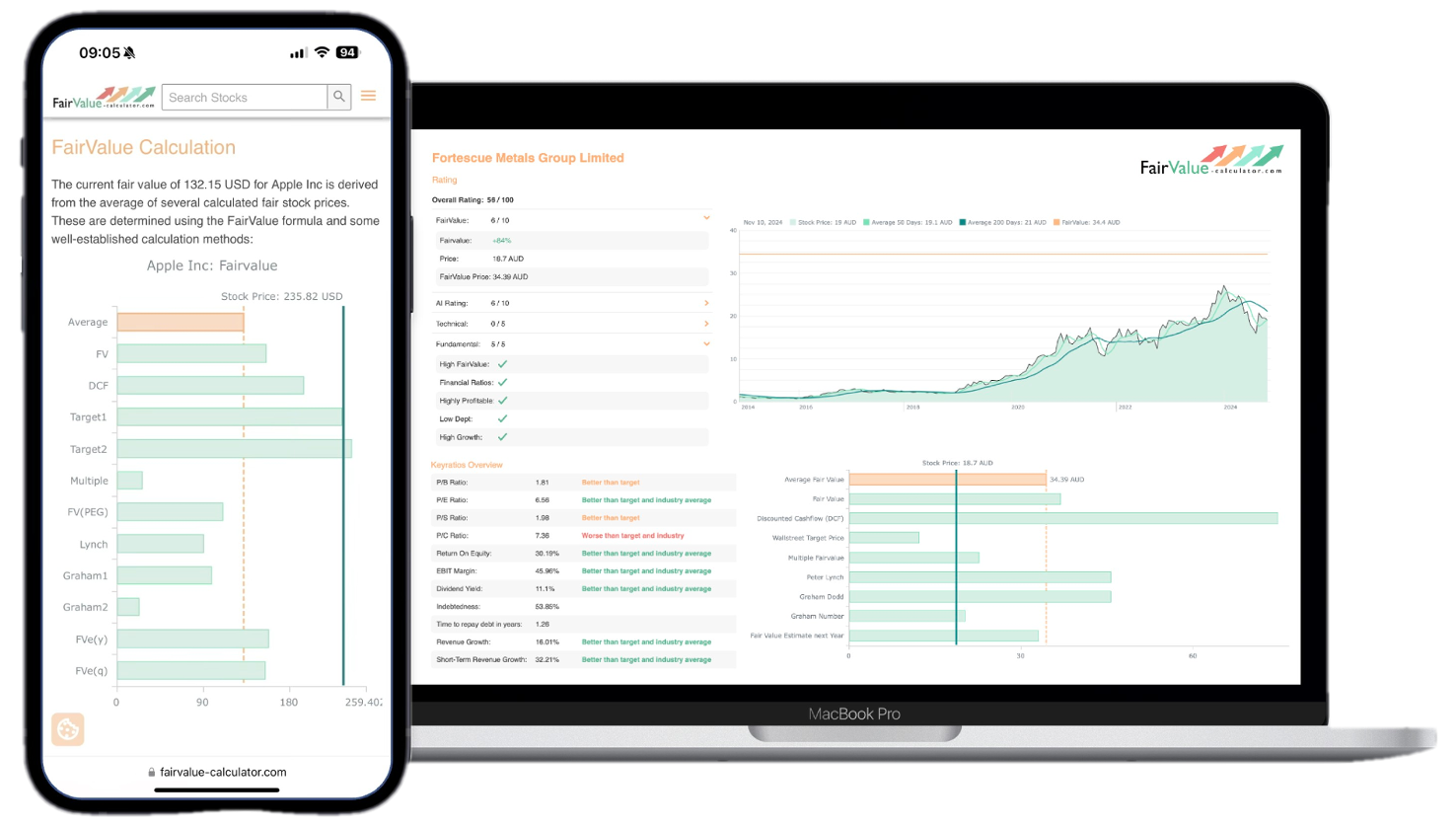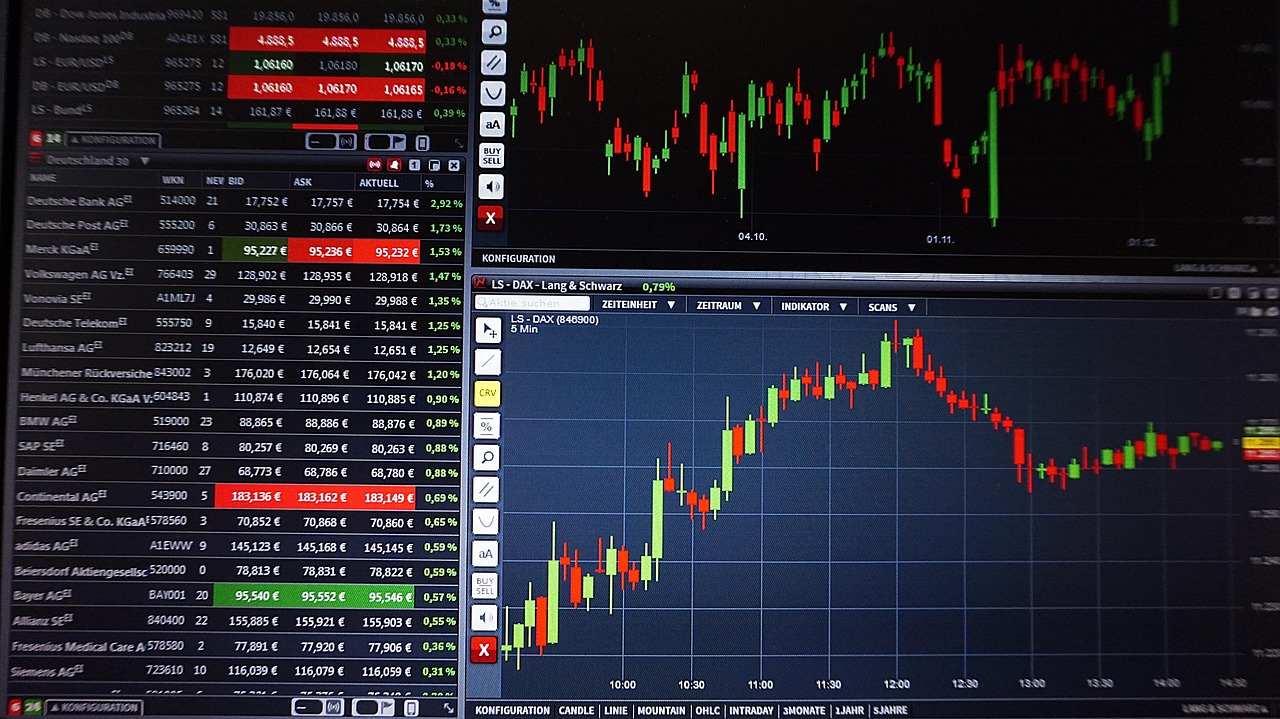The Dividend Discount Model (DDM) Formula
💡 Discover Powerful Investing Tools
Stop guessing – start investing with confidence. Our Fair Value Stock Calculators help you uncover hidden value in stocks using time-tested methods like Discounted Cash Flow (DCF), Benjamin Graham’s valuation principles, Peter Lynch’s PEG ratio, and our own AI-powered Super Fair Value formula. Designed for clarity, speed, and precision, these tools turn complex valuation models into simple, actionable insights – even for beginners.
Learn More About the Tools →It is a method used for valuing a company’s stock price based on the theory that its value is the sum of all of its future dividend payments, discounted back to its present value.
🚀 Test the Fair Value Calculator Now!
Find out in seconds whether your stock is truly undervalued or overpriced – based on fundamentals and future growth.
Try it for Free →In its most basic form, the DDM formula is:
Explore our most popular stock fair value calculators to find opportunities where the market price is lower than the true value.
- Peter Lynch Fair Value – Combines growth with valuation using the PEG ratio. A favorite among growth investors.
- Buffett Intrinsic Value Calculator – Based on Warren Buffett’s long-term DCF approach to determine business value.
- Buffett Fair Value Model – Simplified version of his logic with margin of safety baked in.
- Graham & Dodd Fair Value – Uses conservative earnings-based valuation from classic value investing theory.
- Intrinsic vs. Extrinsic Value – Learn the core difference between what a company’s really worth and what others pay.
- Intrinsic Value Calculator – A general tool to estimate the true value of a stock, based on earnings potential.
- Fama-French Model – For advanced users: Quantifies expected return using size, value and market risk.
- Discount Rate Calculator – Helps estimate the proper rate to use in any DCF-based valuation model.
Price = D1 / (k – g)
Where:
Price = The fair or intrinsic value of the stock today
D1 = Expected dividends in the next period
k = Required rate of return by investors, also known as the discount rate
g = Assumed constant dividend growth rate
Breaking this formula down:
D1 represents next year’s expected dividends per share, for example, $1 per share
k reflects the long-term minimum return investors would require to own the stock, incorporating the risk-free rate plus a stock market risk premium
g stands for the estimated long-term dividend growth rate, for example, 3% annual growth
The D1 is divided by (k – g) to calculate the present value of the stock. The discount rate (k) minus the dividend growth rate (g) is often called the capitalization rate as it converts future dividends into a current stock value.
This formula makes some significant assumptions – that the dividend and growth are constant over time – but provides a relatively straightforward method for evaluating current stock prices based on shareholder yield.
Common DDM Formula Variations
The basic DDM formula can be modified or expanded depending on the needs of the investor or analyst. Some common variations include:
- Multi-Stage Dividend Discount Model: Rather than assuming long-term constant growth, companies often have varying growth rates over different periods. The multi-stage model divides growth assumptions into distinct phases like high growth, tapering growth, and maturity.
- Finite Dividend Horizon Model: This model calculates stock value based on a specified number of years of expected dividends rather than assuming dividends continue indefinitely. This can be appropriate for certain industries and helps model non-constant dividend streams.
- Supernormal Growth Model: Some companies, especially young high-growth firms, experience especially high “supernormal” growth before tapering down to more sustainable rates. This separate period can be factored in before reverting assumptions to long-term trends.
- Corporate Valuation Model: By discounting free cash flows to the firm rather than just dividends, DDM analysis can be expanded to incorporate broader corporate valuation for mergers & acquisitions and other purposes. This market-based approach relies more on projected fundamentals.
Implementing various modifications allows the flexibility to tailor the analysis to different types of stocks with varying dividend policies across distinct corporate life cycle stages.
DDM Formula Examples
To demonstrate how the dividend discount model formula works in practice, a few examples are helpful:
Example 1 – Stable Utility Stock
Florida Power & Light (FPL) has paid quarterly dividends of $0.50 per share over the past year. Analysts expect this to continue over the next year, with 3% annual dividend growth long-term afterward to keep pace with inflation. An appropriate discount rate is estimated to be 6%.
Using the dividend discount model formula:
Price = D1 / (k – g)
D1 = Annual dividend = 4 * $0.50 per quarter = $2
k = 6%
g = 3%
Price = $2 / (0.06 – 0.03) = $50
So with $2 in dividends next year and 3% long-term dividend growth, $50 is the estimated fair value per share based on DDM.
Example 2 – High Growth Tech Stock
A software startup has gone public and currently pays $0.10 per share in dividends annually. Earnings and payouts are expected to grow quickly over the next 5 years before slowing, with estimated dividend growth of 40% (years 1-5) and 5% long-term after that. A reasonable discount rate for the high-risk technology stock is 11%. Using multi-stage DDM:
D1 = $0.10
Short Term g = 40%
Long Term g = 5%
k = 11%
Price = D1(1 + g) / (k – g) for each period:
Year 1-5: $0.10(1.4) / (0.11 – 0.4) = $2.33
Year 6 onward: $2.33(1.05) / (.11 – .05) = $47.60
In this example, allowing for several years of high growth followed by a gradual slowdown gives a much higher current stock valuation compared to assuming constant long-term growth.
These demonstrate just a couple of ways the flexible DDM formula can be used to estimate share prices based on dividend yield projections across different stock profiles.
Dividend Discount Model Shortcomings
Despite providing a relatively simple stock valuation method, the dividend discount model does have several shortcomings to be aware of. Some key limitations include:
- Sensitive to inputs: Small changes to inputs like dividends, growth rates, and discount rates can dramatically impact valuation. Garbage in, garbage out applies – inaccurate assumptions generate inaccurate prices.
- Difficult long-term forecasting: Accurately predicting even next year’s dividends can prove challenging, let alone long-term 30+ year dividend growth. Models overly relying on long-dated forecasts may lack credibility.
- Ignores capital gains: By only considering dividend yield, capital appreciation is ignored. Growth stocks that reinvest earnings rather than distribute dividends would be undervalued by DDM analysis.
- Static analysis: The DDM formula relies on a single discounted cash flow analysis rather than incorporating flexibilities like strategic options that impact corporate value over time. Values can change quickly.
- Theoretical valuation: DDM provides an estimate of intrinsic value based on dividend yield theory, not necessarily actual market pricing which incorporates many other investor behavioral factors. Real-world prices may differ significantly.
While useful under certain frameworks, the many simplifying assumptions and focus strictly on dividends make DDM best suited for certain types of stable, high-yield stocks. Investors should be aware of its shortcomings before overly relying on output from what remains an elegant but theoretical model.
Augmenting traditional DDM analysis with market-based comparables, sensitivity testing different scenarios and cases, and being aware of its limitations allows investors to extract useful information without fully betting on its theoretical outputs.







